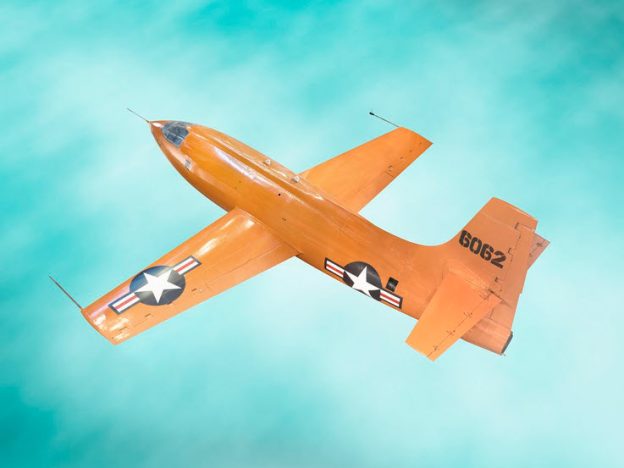It was arguably the most important flight since Kitty Hawk, and the plane was a perfection of form and function. Thirty feet 9 inches long, 10 feet 8½ inches high and 28 feet from wingtip to straight-razor wingtip, the Bell X-1 looked exactly like what had inspired its designers: a .50 calibre bullet. Square-jawed, slender and handsome, with a reassuringly laconic West Virginia drawl, U.S. Air Force Capt. Chuck Yeager sat in the cockpit as the ur-pilot, the epitome of the Right Stuff. On this bright, brisk morning near Rogers Dry Lake in Southern California, October 14, 1947, he was preparing to fly faster than the speed of sound for the first time in recorded history.

Yeager, a 24-year-old ace fighter pilot turned pathbreaking test pilot, was operating the most sophisticated aeronautical science package ever built. Everything that wasn’t Yeager in his tiny cockpit was fuel or wiring or instrumentation. Thousands of pounds of it, all propelled forward in a deafening rush by a rocket engine producing 6,000 pounds of thrust. The program had made dozens of preparatory flights before Yeager eased his throttle forward into history. Larry Bell, head of Bell Aircraft, his chief design engineer Robert Woods, Ezra Kotcher, then an Army major, and John Stack, a research scientist at the National Advisory Committee for Aeronautics (NACA), had been working for years on the supersonic flight; one particular challenge was determining how to fly through the buffeting of the transonic zone, the liminal space between subsonic and supersonic speed, where the very air was the enemy, compressing itself against the plane’s skin, and where the “sound barrier” was said to be. A joint project of NACA and the U.S. Army Air Forces, built by Bell Aircraft of Buffalo, New York, the X-1 reached a speed of 700 miles per hour that bright day, Mach 1.06 at an altitude of 43,000 feet.

This was no headline-grabbing joy ride; it was top-secret research. Still, by December 1947, newspapers and magazines had the story—and the National Aeronautic Association awarded Bell, Stack and Yeager with that year’s Collier Trophy, one of the highest prizes in aviation. Once the X-1 made headlines, Hollywood was keen to give audiences a front-row seat to the supersonic frontier. Indeed, the X-1’s final flight, in 1950, was a cameo in Howard Hughes’ Jet Pilot starring John Wayne and Janet Leigh, which hit theatres (with a thud) in 1957.
The X-1 landed at the Smithsonian in 1950. In presenting the aircraft to Alexander Wetmore, then the Smithsonian Secretary, Air Force Chief of Staff Hoyt Vandenberg said Yeager’s flight that day in 1947 had “marked the end of the first great period of the air age and the beginning of the second. In a few moments, the subsonic period became history, and the supersonic period was born.” Yeager retired from the armed forces in 1975 as a general and visited his old ship at the Smithsonian when he could on the anniversary of their signature flight. After Tom Wolfe published The Right Stuff in 1979, and the big-budget film adaptation arrived in 1983, those visits became rock-star Q and A events. Crowds would fill the National Air and Space Museum’s Samuel P. Langley Theater and spill out into the planetarium, and then 400 or 500 or 600 fans would line up for autographs. To the amazement of the curators, Yeager, who always had to be the fastest, could sign 500 autographs in less than 30 minutes. Today, visitors can see the X-1 at the museum’s Steven F. Udvar-Hazy Center in Virginia. Despite early hopes, supersonic civilian aircraft like the Concorde proved economically unsustainable: high fuel and maintenance costs and too much noise compared with subsonic flight. Yet today several start-ups are trying again.
There was always a powerful appeal in postwar notions of supersonic flight, when a machine like the X-1 promised something like freedom or escape: an imagined life so fast and so high and so clean that nothing bad could ever catch us again. But the unspoken promise of every technology is the one it can’t deliver: transcendence.
The nonmilitary flight eventually became commercial tedium, a series of shoeless corrals leading to a subsonic middle seat, a subpar romantic comedy and a lost suitcase. Global air travel is a miracle when you stop to think about it. But no one does. Instead, we’ve made the very angels ordinary. And when there are no more firsts, we’re left with nothing but our contempt for the familiar. Faster even than a rocket is how quickly the future becomes the past.
But once, long ago, on a blue October morning under the impossible vaults of heaven, one of us rose and flew faster than the roar of our own hopes, and for a moment, everything seemed possible. Source: ‚Smithsonian Magazine‚. Photo-Illustration: Cade Martin.


